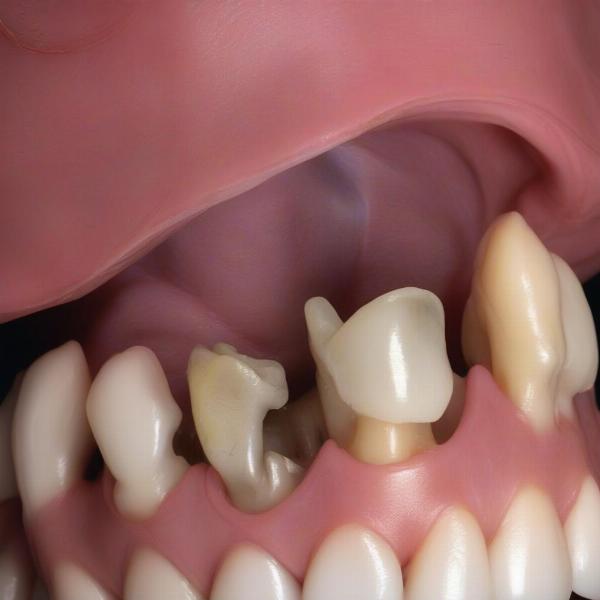Dog tooth decay, also known as periodontal disease, is a serious and unfortunately common problem for our canine companions. Understanding the stages of dog tooth decay, through pictures and descriptions, can help owners recognize the signs early and seek appropriate veterinary care. This article will guide you through the different stages of tooth decay in dogs, provide helpful visuals, and offer practical advice for prevention.
Recognizing the Stages of Tooth Decay in Dogs
Just like in humans, dog tooth decay progresses through various stages, each with its own set of symptoms and potential complications. Early detection is key to preventing irreversible damage.
Stage 1: Plaque Formation
The initial stage of tooth decay begins with the accumulation of plaque, a sticky film containing bacteria, food particles, and saliva. This plaque builds up on the teeth, especially along the gum line. While plaque itself is relatively harmless initially, it creates a breeding ground for harmful bacteria.
Stage 2: Tartar Buildup
If plaque is not removed regularly through brushing, it hardens into tartar (calculus), a rough, brown or yellow deposit that adheres firmly to the teeth. Tartar cannot be removed with brushing alone and requires professional cleaning by a veterinarian.
Stage 3: Gingivitis
The presence of tartar irritates the gums, leading to inflammation known as gingivitis. Signs of gingivitis include red, swollen gums, bad breath, and occasional bleeding during brushing or chewing. At this stage, the damage is still reversible with proper dental care.
Stage 4: Periodontitis
Left untreated, gingivitis progresses to periodontitis, a severe infection that damages the tissues supporting the teeth. The gums recede, pockets form between the teeth and gums, and bone loss can occur. Periodontitis can lead to tooth loss, pain, difficulty eating, and even systemic infections affecting other organs.
 Periodontitis in a Dog
Periodontitis in a Dog
Preventing Dog Tooth Decay: Practical Tips
Preventing tooth decay is far easier and less expensive than treating it. Here are some effective strategies to maintain your dog’s oral health:
- Regular Brushing: Brushing your dog’s teeth daily with a pet-specific toothpaste is the most effective way to remove plaque and prevent tartar buildup.
- Dental Chews and Treats: Dental chews and treats can help scrape away plaque and tartar. Choose products approved by the Veterinary Oral Health Council (VOHC).
- Dental Diets: Some specialized dog foods are formulated to promote dental health.
- Regular Veterinary Checkups: Schedule regular dental checkups with your veterinarian for professional cleaning and examination.
Preventing Tooth Loss in Dogs: A Veterinarian’s Perspective
Dr. Emily Carter, DVM, emphasizes the importance of preventative care: “Regular dental hygiene is crucial for maintaining your dog’s overall health. By implementing a consistent oral care routine, you can significantly reduce the risk of tooth decay and its associated complications.”
Conclusion
Understanding the stages of dog tooth decay, as illustrated by pictures and descriptions, is essential for responsible pet ownership. By implementing preventative measures and seeking timely veterinary care, you can help your furry friend enjoy a healthy, pain-free mouth for years to come. Remember, early detection is key!
FAQ
- How often should I brush my dog’s teeth? Ideally, you should brush your dog’s teeth daily.
- What type of toothpaste should I use for my dog? Always use a toothpaste specifically formulated for dogs, as human toothpaste can be harmful to them.
- Are dental chews effective in preventing tooth decay? Yes, VOHC-approved dental chews can help reduce plaque and tartar buildup.
- What are the signs of advanced tooth decay in dogs? Signs include loose teeth, bad breath, difficulty eating, and swollen gums.
- Can tooth decay in dogs affect their overall health? Yes, advanced tooth decay can lead to systemic infections affecting other organs.
- How much does a dog dental cleaning cost? The cost varies depending on the location and severity of the dental issues, but it can range from $200 to $500 or more.
- What is involved in a professional dog dental cleaning? A professional cleaning typically involves anesthesia, scaling, polishing, and sometimes extractions.
About ILM Dog
ILM Dog (ilmdog.com) is your trusted global resource for expert dog care and breed information. We offer practical advice on Dog Breeds and Selection, Health & Medical Care, Training & Behavior, Nutrition & Feeding, Grooming & Hygiene, and Products & Accessories. We are dedicated to helping dog owners provide the best possible care for their canine companions. For personalized advice or inquiries, please contact us at [email protected] or call us at +44 20-3965-8624.